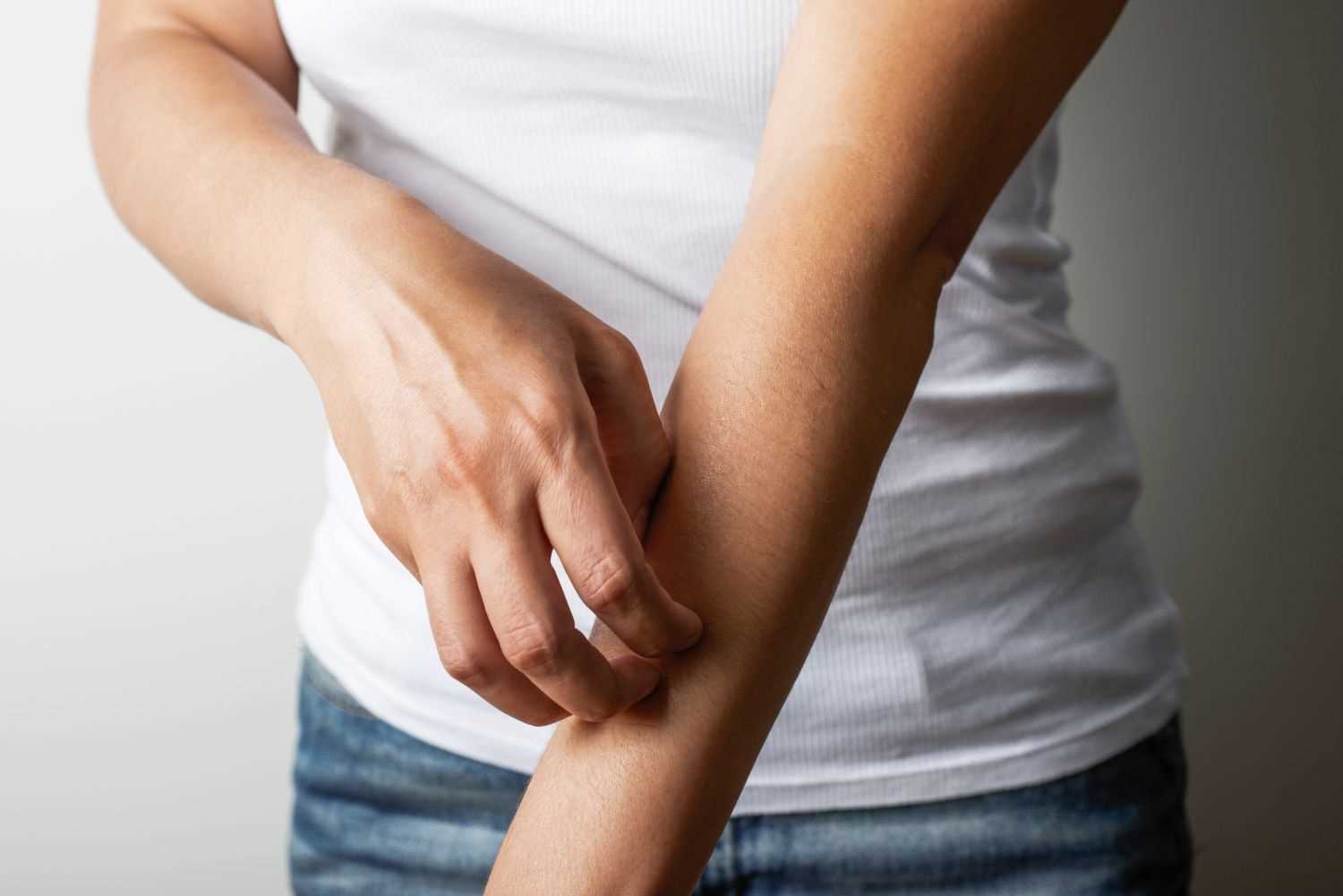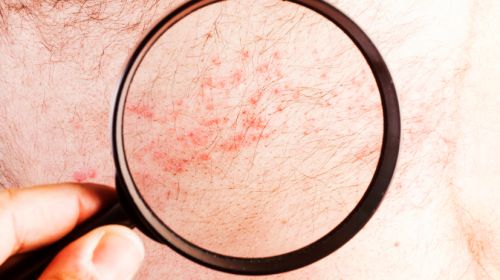Leishmaniasis is a tropical disease transmitted by sand flies. Cases of climate change, mass tourism and migration also occur in Germany in isolated cases.
- After the mosquito bites, itchy nodules develop on the skin.
- © iStock.com/simarik
Leishmaniasis is a tropical disease that is also increasingly occurring in Mediterranean countries and occasionally in Germany. It is triggered by parasites called leishmanias and the infection can affect humans and animals. The Leishmania are transmitted by sand mosquitos and there can be different forms of the disease with very different degrees of severity.
Overview of article content:
What is leishmaniasis?
Infection with a type of leishmania is called leishmaniasis. These are single-celled parasites that mammals, especially rodents, serve as a natural host. There are a total of about 30 different Leishmania species that are transmitted through the saliva of the nocturnal, female sand mosquito (butterfly mosquito, phlebotomes). In humans, twelve types of leishmania are likely to trigger disease symptoms, although the clinical pictures caused differ significantly.
The main form cutaneous leishmaniasis occurs in Europe, the Arab region and Africa. There it is triggered by Leishmania tropica, Leishmania major, Leishmania aethiopica and Leishmania infantum. In Central and South America, however, Leishmania mexicana, Leishmania brasiliensis and Leishmania panamensis are the causative agents of cutaneous leishmaniasis.
The mucocutaneous leishmaniasis affects skin and mucous membranes and is triggered by Leishmania brasiliensis, Leishmania panamensis and Leishmania guyanensis. It occurs particularly in South America.
In the visceral leishmaniasis will affect the skin and internal organs. This form is caused by Leishmania donovani (in East Africa and India) and Leishmania chagasii (in Latin America and the Mediterranean).
Leishmaniasis occurs mainly in the Mediterranean, the Middle East, and Central and South America. Due to climate change, Leishmania can also be found in the temperate zones of Europe and will spread further there.
The different clinical pictures have many different names. Known synonyms for the leishmaniasis species are Orient, Baghdad or Aleppo bump, Kala-Azar, black fever, Dumdum fever or Kala-Azar ("black death").
Frequency: How often does leishmaniasis occur?
The World Health Organization (WHO) ranks leishmaniasis among the 20 neglected tropical diseases. The infectious disease is very common. Worldwide, 700,000-1,200,000 cases with pure skin symptoms and 200,000-400,000 cases with possible organ involvement are assumed worldwide. Every year, 20,000-40,000 people die from leishmaniasis. In total, around 12 million people worldwide suffer from the infection.
The Charité Berlin Tropical Institute recorded ten cases of cutaneous leishmaniasis and two cases of visceral leishmaniasis in Germany in 2017. However, since the disease does not have to be reported, the WHO expects significantly more cases.
How is leishmaniasis transmitted?
The carriers of the Leishmania are sandflies. They feed on blood by scratching the skin with their mouth tools and sucking up the escaping blood. If the bitten animal or human is infected with Leishmania, the sandflies also eat the parasites during the blood meal.
The Leishmanias develop further in the body of the sand mosquitoes and mature there to the infectious form. At the next meal, the sand mosquito then transfers these parasites to a new host, where it reproduces and triggers the infection. The incubation period is weeks to several months, in extreme cases years. So the disease is not directly contagious, the parasites need the sand fly as a so-called vector.
The pathogens are mostly imported to Germany from travelers or migrants from endemic areas. Another, common type of introduction is by infected dogs. Unlike humans, the disease does not heal in dogs.
It is not certain whether the two types of sand mosquitoes native to Germany could result in a transmission of Leishmania. A direct infection via saliva or contact with an infected dog is not possible, since the leishmanias first have to mature into an infectious form in a sand fly.
The pathogen can also be transmitted through blood transfusions or organ transplants and, in rare cases, can pass to the unborn child during pregnancy (congenital infection).
What are the symptoms of leishmaniasis?
With poorly healing stitches as well as nodules or small open skin areas that do not want to heal, you should be alert and think of cutaneous leishmaniasis. Especially if you have made a long-distance trip in the past few months. The same applies to unclear, recurring or persistent fever.
Different symptoms appear depending on the type of pathogen, the type of leishmaniasis and the strength of the person's immune system.
Symptoms of cutaneous leishmaniasis
The skin shape of leishmaniasis usually shows up on the uncovered skin, especially on the face and arms. First you see a small blue-red nodule that spreads quickly. After three to four months, it developed into a several centimeter ulcer that has a raised edge, can be crusty and does not hurt.
So-called bacterial superinfections can cause the wound edge to become very inflamed and painful, and pus can form. After a year or two, the skin defect heals and a scar forms, which is often very unattractive and pigmented. In rare cases, several skin areas can be affected at the same time.
Symptoms of mucocutaneous leishmaniasis
This variant of leishmaniasis affects the mucous membrane and is comparatively rare with two to five percent of cases. Ulcers occur particularly in the nasopharynx. Pharynx, suppository, palate and tongue up to the larynx and trachea can be affected. The ulcers in the throat area can severely hamper food intake. Malnutrition is a possible consequence. The nose and lip area as well as the nasal septum can also be affected. Thickening of the nasal septum occurs, which greatly affects breathing.
Mucocutaneous leishmaniasis can be chronic and, in some cases, occur ten years after a cutaneous course. Secondary infections can cause blood poisoning (sepsis).
Symptoms of visceral leishmaniasis
The most dangerous form of leishmaniasis can affect the skin, liver, spleen, bone marrow and lymph nodes. Dark skin nodules and spots develop and there is a sudden or gradual onset of fever, swelling of the liver and spleen (hepatosplenomegaly), chills, weakness, anemia, bleeding on the skin and mucous membranes and hair loss.
Severe diarrhea and pneumonia can worsen. Infants are often affected, but all ages can fall ill. The mortality rate for untreated patients is 95 percent. The time between infection and onset of the disease (incubation period) is between three months and two years.
How do you diagnose leishmaniasis?
Although leishmaniasis is becoming more common due to mass tourism and the influx of people from high-risk areas, many doctors have no experience with diagnostics yet. To make matters worse, the disease often only breaks out very long after the infection. Sometimes there is no direct connection between the trip and the existing symptoms.
The right contacts for the diagnosis of leishmaniasis are specialists in skin diseases (dermatologists), infectious diseases (infectiologists) or tropical medicine (tropical medicine).
In the first step, the symptoms of the disease are carefully examined and a detailed patient survey (medical history) is carried out.
The most important diagnostic procedure is to take a tissue sample from the affected skin or mucous membrane areas (biopsy). By staining the sample with a specific dye, the approximately two to five thousandths of a millimeter Leishmania become visible under the microscope. Leishmanias can also be visualized in smears or contact samples, but the safer method is biopsy.
The pathogens can be grown in a nutrient medium and the evidence of the disease can be carried out even with small numbers of pathogens. These cultures can also be used to demonstrate which subspecies of the parasite triggers the disease.
To detect visceral leishmaniasis, biopsies from bone marrow, lymph nodes, liver or spleen and the blood must be examined using a PCR (polymerase chain reaction) and under the microscope. If the results are positive, the extent of the disease must be determined by additional examinations such as abdominal ultrasound and X-ray examinations of the lungs. Since leishmaniasis is more common in HIV-positive people, an HIV test is also essential.
Therapy of leishmaniasis
Before treating cutaneous leishmaniasis, you should find out which pathogen is present. In most cases, the skin ulcers heal on their own within one to two years. In addition, the ulcers can be iced up, injected with medication or treated by small surgical interventions.
In some cases, however, surgical manipulation can contribute to the exacerbation of the skin by making the disease really active. After healing, it may be necessary to correct the scar with plastic surgery.
In severe cases of cutaneous as well as in all cases of mucocutaneous and visceral leishmaniasis, drug therapy is required. In most cases, this is administered as an infusion. The following drugs are used, depending on the subspecies of the parasite:
- Antimony preparations
- Pentamidine
- Liposomal amphotericin B
- Ketoconazole
- interferon
Adequate hydration and a healthy diet should also be ensured. If additional infections occur, they must be treated quickly and effectively. Then antibiotics are usually necessary.
Course and forecast
Cutaneous leishmaniasis is the easiest of all types of leishmaniasis and heals on its own. However, there is always a scar even in those affected, which sometimes has to be corrected by plastic surgery.
Mucocutaneous and visceral leishmaniasis is very difficult in most cases, especially in countries with poor medical care. The visceral form is often fatal.
After surviving leishmaniasis, there is immunity to the causative agent. However, other parasites from the Leishmania group can still cause disease.
Can you prevent leishmaniasis?
So far, it has not been possible to develop a vaccine against leishmaniasis.
The so-called exposure protection against the bite by sand mosquitoes is decisive for prevention. Effective insect repellents, long trousers and long sleeves as well as impregnated insect nets offer the best protection against sand mosquitoes. There are special collars for dogs that keep sand mosquitoes away.


